What can we conlude from the night sky we see (np 2385 and after)?
(feel free to add any item you find relevant, with as many details as possible about the method and, if necessary, the hypothesis made)
Latitude[]
Due to the angle of the movement of the stars on the celestial equator, the latitude at which they are currently is of 39,5° North (measured as the angle of the celestial equator, see Star trails).
This result does not make any hypothesis about Earth or anything: the stars can only be seen moving that way if the camera is tilted by 39° compared to the rotation axis of whatever planet they are on.
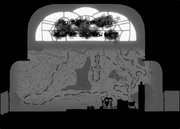
Beanish Map
The Beanish map places their location somewhere in the midst of the Mediterranean prior to the flooding of the basin; this is roughly consistent with the latitudes above.
Constellations[]
The stars line up really well with Scorpius and Sagittarius. We can then see Capricornus and Aquarius, and just before sunrise, Pegasus and Aries. In frame 3081, Taurus, Auriga, and Perseus are visible.
Crucial question: at what time and from what place can they be seen in this way, with planets in Sagittarius and Aquarius (presumably, Venus and Jupiter) at this position?
A map of the constellations and a panorama of the night sky may be viewed here.
Venus[]
The brightest dot is almost certainly Venus. Its position in Sagittarius appears every 8 years, next occurrence being in November 2013.
Moon and Longitude[]
As of now, there is no visible moon in the night sky, which rules out November 2013 (except in a scenario in which the moon has disappeared, or the scene does not take place on earth....)
With the position of the moon and the precise date, we would be able to determine the longitude.
Pixels, Degrees and Time[]
According to Edo, a degree corresponds to 7.9845 pixels; the stars moved 190.56 pixels in 15 np so there is 6.36 minutes per newpix (in this period, where the np rate seems to be constant)
Sun[]
According to jjjdavidson, the Sun would have a diameter of 3 degrees, that is 6 times its actual size.
Star Positions and Precession[]
One possible explanation of the minor differences in some of the star positions in the constellations, between the images and the actual sky, is that the comic takes place millennia in the future. The shapes of constellations over time changes slowly because individual stars are moving relative to one another and relative to the Solar System which is also moving within the galaxy. (See Proper Motion.) Measurements of the displacement of some of the stars that seem to be most "out of position" suggest that Time takes place on earth 12000 to 14000 years in the future.
One other notable difference is the absence of the bright star Antares. As a red supergiant, it is a relatively short-lived star and may have gone supernova (leaving a remnant too dim to be visible to the naked eye) during this timespan.
This time interval is roughly half a complete cycle of precession of the earth's axis. The rotation axis is not totally fixed against the star background, but wobbles to sweep out a cone, with a full rotation every 26000 years. During that cycle, Polaris shifts from being the "north star" nearly aligned with earth's axis, to being up to 47 degrees off the axis, and back again, and the equator tilts relative to the star background so that some constellations south of the equator become north of the equator and vice versa. If the far-future hypothesis is correct, the effects of precession on observations would affect other astronomical analyses such as determination of the latitude and the season of the year.
Galactic Location[]
The sky appears to rotate around its "north point" (which on Earth currently points roughly in the direction of Polaris, the 'North Star'). In the comic, this point seems to be somewhere outside of the upper-right side of the comic frame. However, the image of the Milky Way (or whatever galaxy this is) which rotates into view seems to be aligned mostly towards/away-from this point, rather than being roughly perpendicular to it (plus or minus Earth's axial tilt depending on the season, and the solar system's axial tilt) as it is on Earth. This suggests that the comic may possibly be taking place on another planet, whose axis is pointing in a different direction with respect to the Milky Way than Earth's is.
Star trails[]
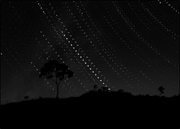
Star trail: frames 1393-2427 (with gamma correction)
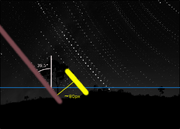
Star trail. Purple: estimated celestial equator. Yellow: path of sunset.
The stars appear to move around celestial poles, the ones on the celestial equator following a straight line. From this we can deduce the latitude (39.5° north).
The sun is in the northern hemisphere, by approximatively 10°, which corresponds to mid-spring (or mid-summer?)
See Rule110's post
The 13291 Hypothesis[]
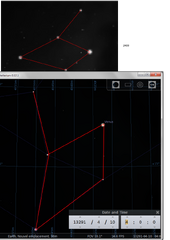
Venus alignment
[Assuming the story takes place on Earth, with no major unnatural event (sudden change of axial tilt, etc.)]
The sky can be matched to the one seen on April 10th 13291, by taking into account:
- the slightly different shapes of the constellations.
- the precession
- the positions of venus and jupiter
- the absence of moon.
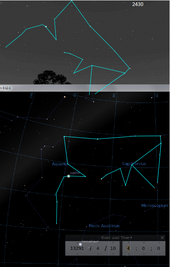
Jupiter alignment.
(NB: it is possible, and even probable, that a few other dates match within a +- 1000 year span around 13291, since the first two constraint are not precise enough under 1ky, and the last two are cyclic with a few years period.)
The positions of Jupiter and Venus and the absence of Moon are corresponding perfectly [according to stellarium], so that frame 2400 should take place at 04h UTC (estimated error: +-4h, thanks to Venus). See alignments, or sidd's version
Under this hypothesis, at 39-40° latitude, the longitudes at which a sunset occurs at the right time correspond to a strip in North America.
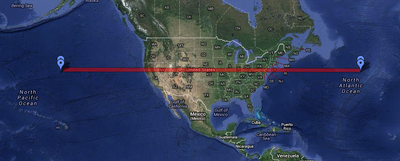
However, probable climatic changes and see level rising in 10k years make precise localisation difficult.
The North American location is clearly contradicted by the maps placing the scene in the Western Mediterranean (dry at the time of the story and about to be re-inundated). This discrepancy may be explained if the cumulative effects of variations in the Earth's rotation amounts to several hours over the 10k year timspan.
Tools[]
http://www.stellarium.org/ is a great tool to verify the stars position at any time or location. (Free and cross-platform.)